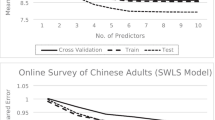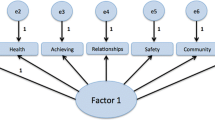Abstract
Importance weighting is a common idea in quality of life (QOL) measurement. Based on the common idea that important domains should have more contributions to individuals’ QOL total score, the weighting procedure of multiplying item satisfaction by item importance was adopted in many QOL instruments. However, in Locke’s [1969, Organizational Behavior and Human Performance 4, pp. 309–336; 1976, in: M.D. Dunnette (eds.), Handbook of Industrial and Organizational Psychology (Rand McNally, Chicago), pp. 1297–1343] range-of-affect hypothesis, he indicated that the satisfaction evaluation of an item was determined by the have–want discrepancy, importance and their interaction (discrepancy × importance), implying that item satisfaction has incorporated the judgment of item importance, therefore, weighting an item satisfaction score with an item importance score is unnecessary. The purpose of this study was to examine the range-of-affect hypothesis in the context of QOL research. Three hundred and thirty two undergraduate students at National Taiwan University (NTU) participated in the study. Item satisfaction, importance and perceived have–want discrepancy were measured for 12 different life-area items. Global life satisfaction was measured as well. Regression analysis results showed that item importance and perceived have–want discrepancy have a significant interaction effect on item satisfaction, supporting Locke’s range-of-affect hypothesis. In addition, regression analysis results also showed that item importance and item satisfaction did not have a significant interaction effect on global satisfaction, suggesting that weighting item satisfaction score by item importance value does not have advantages in predicting global satisfaction. In a summary, the findings revealed that item satisfaction has incorporated the judgment of item importance, and, thus, the procedure of importance weighting on item satisfaction is unnecessary.
Similar content being viewed by others
References
Arrindell W.A., Heesink J. and Feij J.A (1999). The Satisfaction With Life Scale (SWLS): Appraisal with 1700 health young adults in the Netherlands. Personality and Individual Differences 26: 815–826
Arrindell W.A., Meeuwesen L. and Huyse F.J. (1991). The Satisfaction with Life Scale (SWLS): Psychometric properties in a non-psychiatric medical outpatients sample. Personality and Individual Differences 12: 117–123
Atienza F.L., Balaguer I. and Garcia-Merita M.L. (2003). Satisfaction with Life Scale: analysis of factorial invariance across sexes. Personality and Individual Differences 35: 1255–1260
Cummins R.A. (1997). Comprehensive Quality of Life Scale – Adult: Manual. University Australia, Deakin
Diener E., Emmons R.A., Larsen R.J. and Griffin S. (1985). The Satisfaction with Life Scale. Journal of Personality Assessment 49: 71–75
Dijkers M.P. (2003). Individualization in quality of life measurement: Instruments and approaches. Archives of Physical Medicine and Rehabilitation 84: S3–14
Ewen R.B. (1967). Weighting components of job satisfaction. Journal of Applied Psychology 51: 68–73
Ferrans C. and Powers M. (1985). Quality of Life Index: Development and psychometric properties. Advances in Nursing Science 8: 15–24
Frisch M.B. (1992). Use of the Quality of Life Inventory in problem assessment and treatment planning for cognitive therapy of depression. In: Freeman, A. and Dattlio, F.M. (eds) Comprehensive Casebook of Cognitive Therapy, pp. Plenum Press, New York
Frisch M.B., Cornell J., Villanueva M. and Retzlaff P.J. (1992). Clinical validation of the Quality of Life Inventory: A measure of life satisfaction for use in treatment planning and outcome assessment. Psychological Assessment 4: 92–101
Hsieh C.M. (2003). Counting importance: The case of life satisfaction and relative domain importance. Social Indicators Research 61: 227–240
Lewis C.A., Shevlin M.E., Bunting B.P. and Joseph S. (1995). Confirmatory factor analysis of the satisfaction with life scale: replication and methodological refinement. Perceptual and Motor Skills 80: 304–306
Locke E.A (1969). What is job satisfaction?. Organizational Behavior and Human Performance 4: 309–336
Locke E.A. (1976). The nature and causes of job satisfaction. In: Dunnette, M.D. (eds) Handbook of Industrial and Organizational Psychology, pp 1297–1343. Rand McNally, Chicago
Lucas R.E., Diener E. and Suh E. (1996). Discriminant validity of well-being measures. Journal of Personality and Social Psychology 71: 616–628
McFarlin D.B., Coster E.A., Rice R.W. and Coopper-Alison T. (1995). Facet importance and job satisfaction: Another look at the range of affect hypothesis. Basic and Applied Social Psychology 16: 489–502
McFarlin D.B. and Rice R.W. (1992). The role of facet importance as a moderator in job satisfaction processes. Journal of Organizational Behavior 13: 41–54
Michalos A.C (1985). Multiple discrepancy theory (MDT). Social Indicators Research 16: 347–413
Mikes P.S. and Hulin C.L. (1968). Use of importance as weighting component of job satisfaction. Journal of Applied Psychology 52: 394–398
Mobley W.H. and Locke E.A. (1970). The relationship of value importance to satisfaction. Organisational Behavior and Human Performance 5: 463–483
Oishi S., Diener E., Suh E. and Lucas R.E. (1999). Value as a moderator in subjective well-being. Journal of Personality 67: 157–184
Pavot W. and Diener E. (1993). Review of the satisfaction with life scale. Psychological Assessment 5: 164–172
Pavot W., Diener E., Colvin C.R. and Sandvik E. (1991). Further validation of the Satisfaction evidence for the cross-method convergence of well-being. Social Indicators Research 28: 1–20
Raphael D., Rukholm E., Brown I., Hill-Bailey P. and Donato E. (1996). The quality of life profile-Adolescent version: Background, description, and initial validation. Journal of Adolescent Health 19: 366–375
Rice R.W., Gentile D.A. and McFarlin D.B. (1991a). Facet importance and job satisfaction. Journal of Applied Psychology 76: 31–39
Rice R.W., Markus K., Moyer R.P. and McFarlin D.B. (1991b). Facet importance and job satisfaction: Two experimental tests of Locke’s range of affect hypothesis. Journal of Applied Social Psychology 21: 1977–1987
Sachs J (2003). Validation of the Satisfaction with Life Scale in a sample of Hong Kong University students. Psychologia 46: 225–234
Saxena S., Carlson D., Billington R. and Orley, J. (2001). The WHO quality of life assessment instrument (WHOQOL-Bref): The importance of its items for cross-cultural research. Quality of Life Research 10: 711–721
Shevlin M.E., Brunsden V. and Miles J.N.V (1998). Satisfaction with Life Scale: analysis of factorial invariance, mean structures and reliability. Personality and Individual Differences 25: 911–916
Shevlin M.E. and Bunting B.P. (1994). Confirmatory factor analysis of the satisfaction with life scale. Perceptual and Motor Skills 79: 1316–1318
Shin D.C. and Johnson D.M. (1978). Avowed happiness as an overall assessment of the quality of life. Social Indicators Research 5: 475–492
Skevington S.M. and O’connell, K. (2004). Can we identify the poorest quality of life? Assessing the importance of quality of life using the WHOQOL-10. Quality of Life Research 13: 23–34
Staples D.S. and Higgins C.A. (1998). A study of the impact of factor importance weightings on job satisfaction measures. Journal of Business and Psychology 13: 211–232
Streiner D.L. and Norman G.R. (1995). Health measurement scales: A practical guide to their development and use, 2nd edition. Oxford University Press, New York
Trauer T. and Mackinnon A. (2001). Why are we weighting? The role of importance ratings in quality of life measurement. Quality of life research 10: 579–585
Waters L.K. (1969). The utility of importance weights in predicting overall job satisfaction and dissatisfaction. Educational and Psychological Measurement 29: 519–522
Waters L.K. and Roach D. (1971). Comparison of unweighted and importance- weighted job satisfaction measures for three samples of female office workers. Psychological Reports 28: 779–782
Westaway M.S., Maritz C. and Golele N.J. (2003). Empirical testing of the satisfaction with life scale: A South African pilot study. Psychological Reports 92: 551–554
Welham J., Haire M., Mercer D. and Stedman T. (2001). A gap approach to exploring quality of life in mental health. Quality of Life Research 10: 421–429
Wrosch C., Scheier M.F., Miller G.E., Schulz R. and Carver C.S (2003). Adaptive self-regulation of unattainable goals: Goal disengagement, goal re-engagement, and subjective well-being. Personality and Social Psychology Bulletin 29: 1494–1508
Wu, C.H. and G. Yao: in press (a), ‘Do we need to weight satisfaction scores with importance ratings in measuring quality of life?’, Social Indicators Research
Wu, C.H. and G. Yao: in press (b), ‘Analysis of factorial invariance across gender in the Taiwan version of the Satisfaction with Life Scale’, Personality and Individual Differences
Author information
Authors and Affiliations
Corresponding author
Rights and permissions
About this article
Cite this article
Wu, CH., Yao, G. Do We Need to Weight Item Satisfaction by Item Importance? A Perspective from Locke’s Range-Of-Affect Hypothesis. Soc Indic Res 79, 485–502 (2006). https://doi.org/10.1007/s11205-005-5666-5
Accepted:
Published:
Issue Date:
DOI: https://doi.org/10.1007/s11205-005-5666-5




